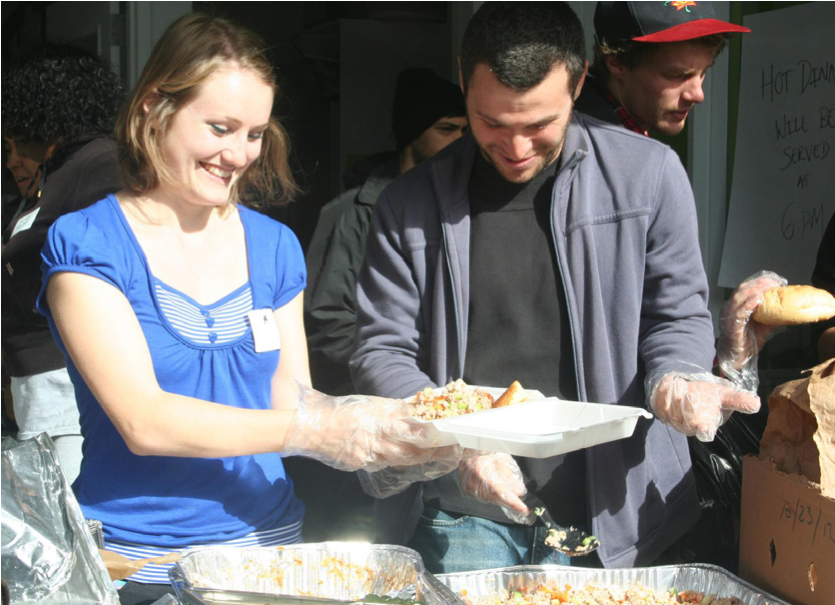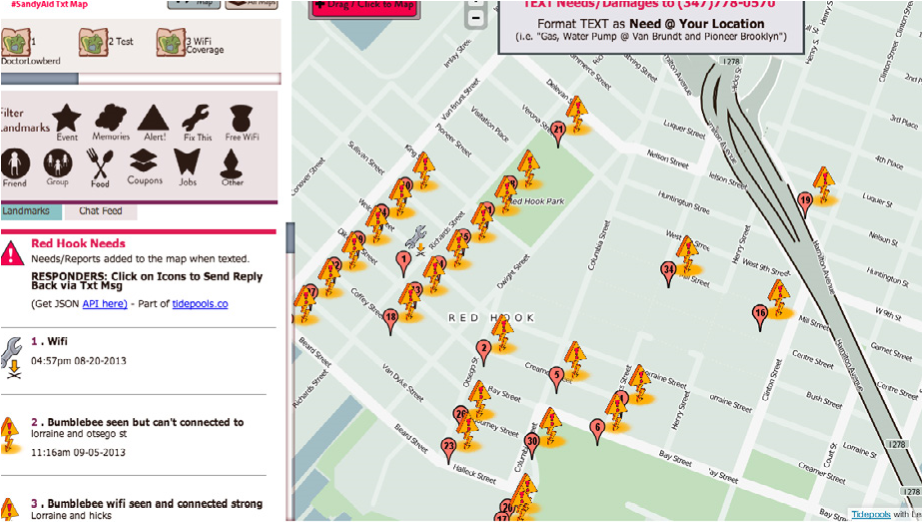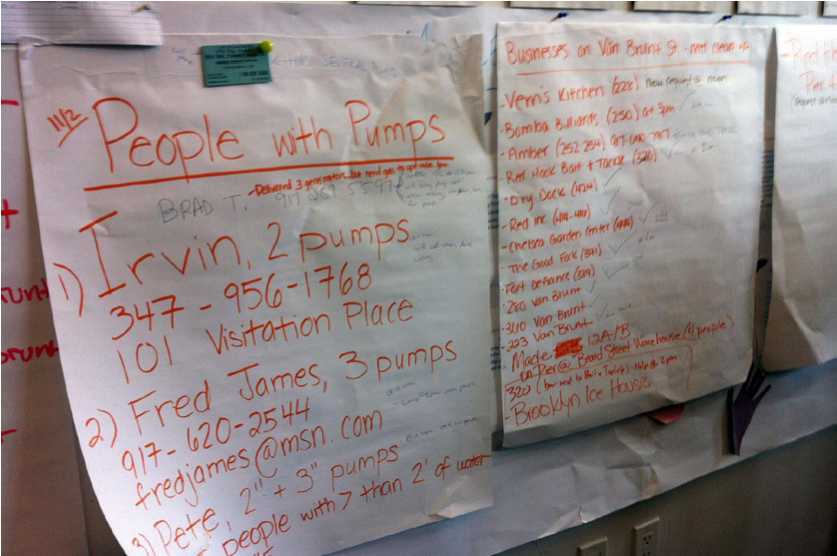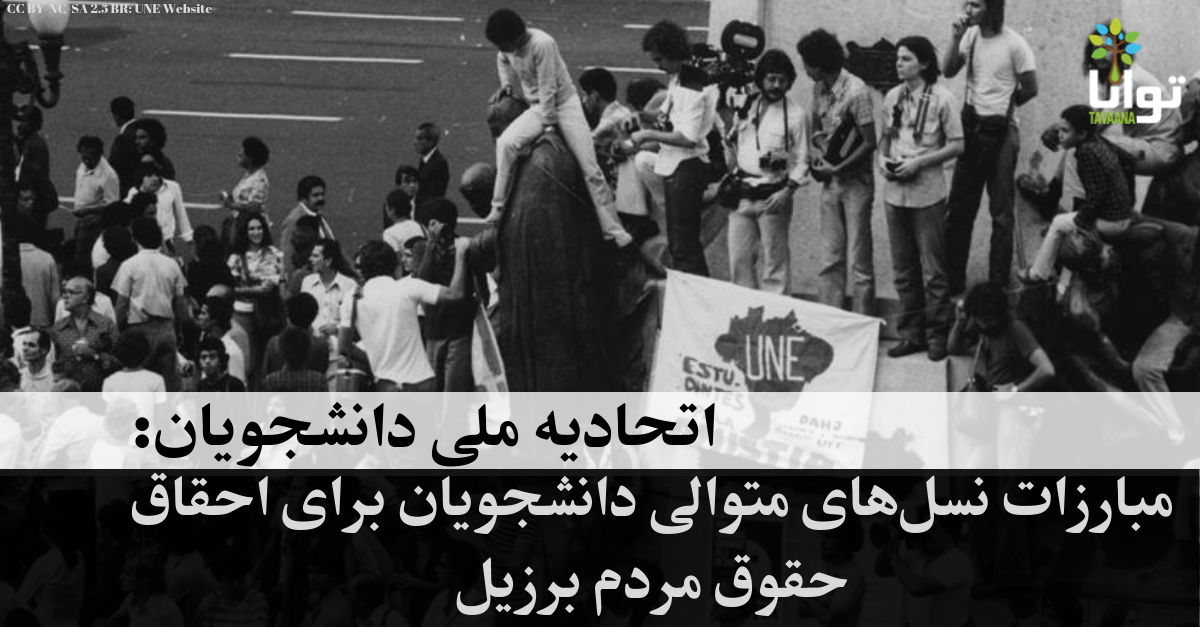Vision and Motivation
Shocked by the scope of the tragedy, organizations, corporations, and ordinary people were moved to join the aid effort out of devotion to their neighborhoods and empathy for those affected. An assortment of citizen groups were mobilized into action, united by the belief that through harnessing the power of technology, local people could use their unique skill sets to speedily and effectively respond to the needs of those around them. Ronny Kmiotek, a retired police officer who lost everything in the flooding, marveled at the sense of community awakened by the emergency: “This storm [and its aftermath] just brought everyone here together, and I am really thankful for all the help we are getting from people.”[2]
Goals and Objectives
The organization People’s Relief, originally founded to deliver medicine in the wake of 2005’s Hurricane Katrina, focused on delivering their services to the elderly and disabled populations of Coney Island. Ilma Joyner, a longtime resident of a public housing development in Coney Island, explained that “of the more than 600 residents who lived in the development, more than 100 who remained after the storm were elderly or had special needs, such as being bound to a wheelchair.”[4] These residents were often deprived of supplies and unable to leave their homes. People’s Relief canvassed buildings like Joyner’s every day, knocking on the doors of the homebound to ensure their wellbeing and bring supplies as needed.

The Red Hook Initiative sought to address a similar issue in Red Hook, Brooklyn. Although the initiative normally provided social programs and support to youth in the Red Hook area, after the hurricane, it focused on obtaining medical treatment and delivering prescription medication to local residents trapped in their homes.[5] The initiative even implemented a makeshift clinic in the Red Hook Initiative community center, so that neighbors with medical emergencies could be treated by on-call medically trained professionals in the event that 9-1-1 and other emergency responders were too slow or busy.
Even for-profit corporations took an active role in helping hurricane survivors. Airbnb is a company that earns money through commissions from apartment rentals on its website. In the aftermath of Hurricane Sandy, however, the website partnered with New York City officials to waive all fees for free listings in New York City offered by good samaritans seeking to provide shelter to the affected. “There are thousands more people in need of shelter,” Airbnb wrote on its blog, “and there are still thousands of people with extra space. It’s time to come together.”[6] Over 1,000 Hurricane Sandy victims found temporary shelter through this initiative. One participant from Staten Island described his experience: “The second I walked in the door, I was greeted by [my host] and her boyfriend and this little puppy dog that made me feel like I was just visiting a family member.”[7]
SeeClickFix also utilized its existing technology to serve in the wake of Hurricane Sandy. The website was originally founded in 2008 as a way for New Haven, Connecticut residents to report non-emergency issues such as graffiti to city authorities and to facilitate greater transparency and government accountability. After Sandy, 911 responders were overwhelmed with critical emergency callers. SeeClickFix offered a forum for citizens to report non-emergency issues, such as downed trees, power outages, or clogged storm drains in their neighborhoods by clicking “Report the issue” on their website. Other citizens could then use the list of issues to avoid dangerous areas or call for help.

The storm’s impact also inspired small groups of ordinary citizens to create new initiatives. In Bay Ridge, Brooklyn, a group of three friends singlehandedly started their own pop-up soup kitchen, Bay Ridge Cares Kitchen, which served over 800 meals a day to victims of Hurricane Sandy. The Kitchen was run from the basement of a church and largely depended on donations from local farmers and restaurant owners for supplies. Allison Robicelli, one of the kitchen’s founders, and a well-known local restaurant owner, describes the group’s motivation: “You want to feed their souls. You don’t want them to think, ‘oh, this is just someone else’s garbage that they’re throwing away.'” [8] Volunteers and local members of the food industry helped to produce the finest meals possible. One woman, after eating a Bay Ridge Cares meal, emotionally thanked the staff for making her a salad, as she had not eaten greens in a week.
Occupy Sandy, People’s Relief, The Red Hook Initiative, Airbnb, SeeClickFix, and Bay Ridge Cares Kitchen represent only a fraction of the citizen-led relief efforts that emerged in the wake of the Hurricane Sandy. While each group utilized different means of contributing to the effort, they all shared a common purpose. Each group brought their respective community together, using their pre-existing skills, resources, and social networks, to bring aid to the most vulnerable citizens of the New York area. Whether through cooking, gathering supplies, or providing shelter, each group aimed to bolster the weaknesses and fill the gaps left by government assistance.

Leadership
Many ordinary citizens with special skills emerged as leaders in the wake of Hurricane Sandy. One of these leaders was Matthew Kraushar, a medical student who first started the Red Hook Initiative Sandy effort. At first, Kraushar was reluctant to spearhead the effort, as he thought, “I’m just a medical student!” However, he was convinced to take action when approached by a city council member who said, “We have nothing. There’s no state or federal help coming in here, and we’re worried there are people stuck in their homes.”[9] Concerned about patients without access to their doctors and medicines, Kraushar and his volunteers began knocking on neighborhood doors to ensure residents’ welfare. If not for Kraushar’s leadership, many at-risk individuals, such as the disabled or the elderly who may not be able to leave their homes on their own, would never have gained access to the medicine or medical care they needed. Kraushar is one example of the numerous citizen leaders who stepped up to organize hurricane relief efforts. These individuals were able to evaluate needs specific to their own communities, make decisions, and garner support to lead volunteers in the right direction.
Ultimately, the Occupy Sandy movement emerged as the leader of the grassroots relief effort. The movement’s flexibility and lack of hierarchy gave them the ability to respond quickly to many different needs. Using social media, Occupy Sandy was able to collect resources for organizations in need. Tweets such as “Red Hook Initiative needs bowls and paper plates for food”, “Sunset Park Volunteer Hub needs Ham Radios and Operators or VHF Marine Radios,” and “If you have a car or truck and want to help transport donated goods & volunteers, link in by texting ‘@osdrivers’ to 23559,”[10] helped connect those wanting to contribute help with those in need. With so many new and different relief organizations, there was a need for coordination, not only within the groups, but also between them. Occupy Sandy took on the role of coordinator between movements. By coordinating and generating collaboration between all the different citizen groups, the Occupy Sandy movement was able to foster a more equitable distribution of aid, making sure that all groups had the supplies they needed, and that one community was not overloaded with help while another was overlooked.
Civic Environment
Hurricane Sandy was the worst storm to have hit the northeastern United States in multiple decades, leaving over 62 billion dollars in damage.[11] The US government attempted to respond quickly and effectively to the damage; when Sandy reached the East Coast, FEMA teams and resources were already in place to begin helping the millions of people affected by the storm’s immediate impact.

Message and Audience
Citizen groups were paramount to communication and mobilization. Occupy Sandy used online gift registries to list needed donations and facilitate direct shipping of donations to the areas in need. Airbnb produced a YouTube video highlighting participants’ positive experiences and calling for more help. Allison Robicelli of Bay Ridge Cares Kitchen described her approach to outreach: “I figured if I just started yelling on Twitter as loud as I could, people would  realize there were a lot bigger problems than what was going on with the subways or not having Internet.” [14] The city responded quickly, and soon after her first tweet, the Bay Ridge Cares Kitchen received a generous food donation from a local deli. The Red Hook Initiative also made use of Twitter to attract volunteers. Volunteer Jamie Feldmar had donated supplies, but wanted to contribute in a more hands-on way. He said, “I’d been following Red Hook Initiative’s Twitter and saw that they needed volunteers for cleanup and meal distribution, so I headed to their headquarters…to sign up.” [15]
realize there were a lot bigger problems than what was going on with the subways or not having Internet.” [14] The city responded quickly, and soon after her first tweet, the Bay Ridge Cares Kitchen received a generous food donation from a local deli. The Red Hook Initiative also made use of Twitter to attract volunteers. Volunteer Jamie Feldmar had donated supplies, but wanted to contribute in a more hands-on way. He said, “I’d been following Red Hook Initiative’s Twitter and saw that they needed volunteers for cleanup and meal distribution, so I headed to their headquarters…to sign up.” [15]
Social media proved an excellent way to reach people due to its ability to quickly reach large and diverse audiences. Rather than asking individuals for help, groups were able to make requests via social media, and thus get a real-time, complete understanding of options, resources, and services available to them. They were able to call upon organizations with similar objectives to promote collaboration. They were able to reach out to potential volunteers, emphasizing the necessity of their service. Most importantly, however, they were able to support the hurricane victims by visibly assuring them that they were cared for, and that help was on the way.

Outreach Activities
Even in 2014, the community-based help efforts that sprang up after Hurricane Sandy continue to operate. Airbnb has learned from the success of their Hurricane Sandy project and has expanded to offer free housing services for disaster situations in all parts of the world. People’s Relief helps to empower local communities as they continue to work in Coney Island, fostering grassroots leadership. Occupy Sandy has shifted its focus from its initial relief efforts and now works with homeowners in vulnerable areas, teaching hurricane victims how to conduct sit-ins and peaceful protests in the face of government eviction from their homes. As the immediate need for aid and supplies abated, the relief efforts remained strong, evolving to meet changing needs of citizens in recovering communities. One example of this is the Sandy Storyline Project, which gives victims the opportunity to heal through a process of reflecting and remembering, to come together with their neighbors, and to make heard “how things were before the storm and how they want them to be better.” [16]
The Hurricane Sandy relief effort demonstrated the importance of local responders who know and respect the neighborhoods in which they work. Citizen groups learned that they needed to not only repair the physical damage, but also to heal and empower the affected communities. As New York City resident and former firefighter Patrick Zoda puts it, “We support each other. This is my home, I’m not going anywhere.” [17]
Learn More
News & Analysis
Feueur, Alan. “Occupy Sandy: A Movement Moves to Relief.” New York Times. 9 November 2012.
Macfarguhar, Larissa. “Occupy Sandy.” The New Yorker. 3 November 2012.
Kilkenny, Allison “Occupy Sandy: One Year Later.” The Nation. 28 October 2013.
“Hurricane Sandy Fast Facts.” CNN Library. 13 July 2013.
Multimedia
“Red Hook Initiative: A Community Response to Hurricane Sandy.” Red Hook Initiative. 2013.
Organizational Webpages
Hurricane Sandy. Wikipedia. 30 July 2014.
Occupy Sandy. Wikipedia. 20 June 2014.
Red Hook Initiative. “We are the Change.” 2014.
SeeClickFix. “How it Works.” 2014.
Footnotes
[1] Fahey, Johnathan. “Hurricane Power Outages After Sandy Not Extraordinary, According To Report Analyzing Katrina, Past Storms.” Huffington Post. 16 November 2012.
[2] Taylor, Alan. “Hurricane Sandy: Staten Island Survivors.” In Focus with Alan Taylor. The Atlantic. 21 November 2012.
[3] Davis, Rebecca. Duerson, Meena Hart. “Occupy Sandy relief effort puts Occupy Wall Street activists in the spotlight again a year after Zuccotti Park.” NY Daily News. 10 December 2012.
[4] Marans, Daniel. “In Coney Island Public Housing, People’s Relief and Local Residents Fill Void Left by Government.” Huffington Post. 19 November 2012.
[5] Albrecht, Leslie. “Med Student Sets Up Makeshift Clinic to Help Red Hook’s Sandy Victims.” DNA Info New York. 9 November 2012.
[6] Wagle, Vivec. Air Bnb Blog. 7 November 2012.
[7] “AirBnb’s Hurricane Sandy Story.” AirBnb. Youtube.
[8] Crowley, Chris E. “Bay Ridge Cares Kitchen: Sandy Relief Through Feeding the Soul.” Serious Eats. 29 November 2012.
[9] Gush, Lauren. “Finding them first: Med student spearheads rescue and relief in Brooklyn after Sandy.” Foxnews.com. 20 November 2012.
[10] “Occupy Sandy Emerges As Relief Organization For 21st Century, Mastering Social Networks.” Huffington Post. 5 November 2012.
[11] Crutsinger, Martin. “Sandy Economic Damage Worse Than Expected At $62 Billion.” Huffington Post Business. 29 November 2012.
[12] Jaffe, Sarah. “After Sandy, disaster response needs not less government, but better.” The Guardian. 6 November 2012.
[13] Crowley, Chris E. “More Than Just Cupcakes: Robicelli’s Bakery on the Front Line of Sandy Relief.” Serious Eats. 7 November 2012.
[14] Ibid.
[15] Feldmar, Jamie. “Sandy Volunteer In Red Hook Shares Experience, Offers Advice.” The Gothamist. November 2012.
[16] “The Best Person to Tell Your Story is You.” Occupy Sandy Net. 31 December 2013.
[17]Taylor, Alan. “Hurricane Sandy: Staten Island Survivors.” In Focus with Alan Taylor. The Atlantic. 21 November 2012.




